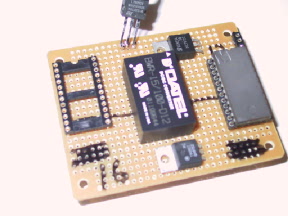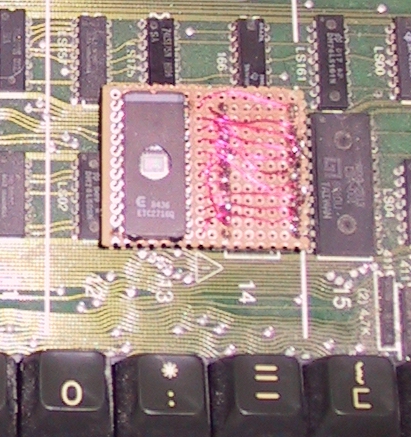
ADM-3A Lower Case Option "Clone"
The ADM-3 originally did not have lower case capability as far as I can recall. The ADM-3A, however, had this optionally available. All there was to it was two 2102-1 RAM chips and a lower case ROM, built much like the famous early 2513 character generator, except it had lower case characters. All one needed to do to install the option was add the two RAMS, the ROM (sockets were already installed), flip a few switches, and there you were. This was a fairly expensive option at one time (in fact, a strippo ADM-3A could only show 12 lines at a time - extra RAMS were installed to obtain the full 24x80 screen, at least until the price for RAM became so low as to make this silly).
The lower case ROM is basically unobtainable-the last source I knew of was Jameco, and they don't seem to have
it anymore. However, I knew it's pinout, and I had one in my other ADM-3A. So, I built a 2513 to 2716 "reading"
adapter for my EPROM progammer. This was slightly tricky because the 2513 type ROMS were PMOS, and required -5
and -12 in addition to +5 with which to operate. I used a wall wart, and an on-board DC-DC converter run through
linear positive and negative regulators to obtain these voltages. Extra care was taken so as not to destroy an
"irreplaceable" part.
Wiring was straightforward, chip selects were both negative going; 5 data bits and 9 address bits were of significance. I copied the ROM, blew a 2716, and made a small adapter board to permit the installation of a 2716 into the ADM-3A's lower case 2513 socket. No socket was used for the 2716 because of concerns with height (later shown to be unjustified).
It worked first crack. The characters are ugly (there is only a 5x7 matrix, so no decenders are possible) but they were just great when you were used to looking at a very worn out ASR-33 teletype output in 1978!
I would recommend using a modern, not vintage, NMOS UVEPROM for this purpose, should you undertake building something like this. The 2513 was rated at 400 ns, and most original 2716's were rated at 450 ns. More modern UVEPROMS (even recently made 2716's, and by recently, I mean mid 1980's) probably beat this by a wide margin. Keep in mind that 2102-1's were specifically specified in the ADM service manual, not the slower "straight" variety.
Below are the bit patterns as described above for the upper and lower case ROM's: Because there are darned few
ways to make a legible 5x7 character matrix, I doubt if there will be copyright issues:

Figure 1. 2513 Adapter Board (Soon disassembled after use for other projects, 2513 Shown in Socket)

Figure 2. Installed Adapter Board

Figure 3. Screen Shot of Upper/Lower Case